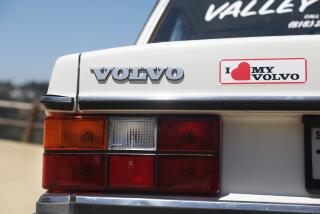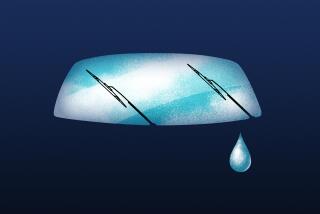BMW’s bigger, better Rolls
- Share via
Not since torch-wielding peasants chased Frankenstein’s monster through the town square has such a noble spirit been so mercilessly taunted. One critic compared the new $320,000 Rolls-Royce Phantom to a coffin maker’s “Executive Slumber Series”; another called it the world’s most majestic air conditioner.
Allow me to pile on.
Man, this thing is ugly.
Yet from the driver’s seat, the Phantom is a sensational automobile. There’s magic and mystery here, fistfuls of romantic motoring. I could drive it to the crack of doom.
Like Shelley’s maledicted hero, the styling of the 2004 Rolls-Royce Phantom is something of a cut-and-stitch job. Rolls-Royce’s chief stylist for exterior design, Marek Djordjevic, scoured the company’s picture books for design cues and proportions that he considered elemental to the marque -- a visual vivisection, if you will. The long hood, the short rear deck, a rising sill line, the convergent hood lines, all poised over a long wheelbase and fronted by a chrome rictus of a grille. These elements he sewed together to form the Phantom, the first new Roller produced under BMW’s ownership.
For example, Djordjevic lifted the massive “blind quarter” of the new Phantom -- the broad sheet-metal pillar aft of the rear window -- from the Hooper-bodied Phantom limousines of yore (in the glory days of Rolls-Royce, buyers would send the bare chassis to coach builders such as Hooper to be fitted with a custom body).
Djordjevic also decided that the new car needed classic coach doors, hinged at the rear. The blind quarters and coach doors combine to create one of the new car’s signature pleasures: Open a rear door, which feels as heavy as one of Ghiberti’s Gates of Paradise, and step easily into the spacious rear compartment, barely ducking your head, then settle back in the leather banquette, secluded in aristocratic privacy behind the blind pillar. So, point to Rolls-Royce. Jolly good show on the coach doors.
Other quintessential double-R design elements in the Phantom are the blade edge of the front fenders; the headlight assembly set high in the “catwalk” between the Greek temple grille and the fenders; and the round fog lights situated just above bumper level (the simulacra of polished Lucas lamps).
But certainly the features that have most thrown viewers are the car’s oppressive bulk and its crazy face. This new slab-sided Phantom is more than 19 feet long (longer than a Ford Excursion) and well above 5 feet tall, possessing something of the visual grace of a container ship. Djordjevic based his design, and its scale, on Rolls-Royces pre-1972. These were some awfully big cars, and in the current context, the Phantom reads almost comically big.
And then there’s the car’s front. It looks like the face of one of those robotic pet dogs they sell in Japan.
What could have possessed Djordjevic? I spent an evening with the young designer in Santa Barbara some months ago, and he seemed to have had all his marbles. What gives?
To begin, ask what exactly did BMW buy when it purchased the rights to the Rolls-Royce name from Vickers (the parent company of Rolls-Royce Motor Cars Ltd.)? Rolls-Royce was a shambles by the time BMW came along in 1998. The Museum-of-the-Industrial-Age Rolls factory in Crewe, England, was dirty and dim. The cars were awful. The only thing in the pipeline was soot.
Rolls-Royce’s single salable asset was its history, its book of myths and legends lavishly illustrated with gorgeous cars dating to Edward VII. For the Phantom, BMW built a brand-new factory in Sussex, on the Earl of March’s Goodwood property, and started from scratch. In fact, there is no “Rolls-Royce” in the sense of a continuous business enterprise started by Hank Royce and Chuck Rolls. To think of the new Rolls-Royce as anything other than the high-tech, super-luxury brand adjunct to the Bayerische Motoren Werke is to willfully suspend disbelief.
But some fictions are fun, even necessary. And for the fiction of Rolls-Royce to remain operable, BMW needed to make the car more British than King Arthur Pendragon, more aristocratic than Lord Mountbatten, more Rolls than Henry’s dear old dad.
My guess is that the styling was driven over the top by the design team’s anxiety over authenticity. What began as a paean to the past wound up looking like it had bolts in its neck.
What’s it like to drive? I’m tempted to say it drives like a Rolls-Royce, but that too may be a sort of wishful back formation, a trick of memory. No Rolls-Royce of the former regime was half so luscious or so purely seductive.
The pleasure begins with the way the car situates itself around you. The driver’s seat is more like a driver’s throne, with a commanding view outward, the long reach of the hood stretching into the scenery. The eye position is as high as in many SUVs. The central console between the seats pairs with the door bolsters to create armchair-like support at the elbows -- though it is easy to inadvertently pop open the console’s compartments. Also, the power-seat controls are secreted in the console, so adjusting the seat position takes some attention.
One of the direct drafts from parent BMW is the Rolls “Command” panel, a dumbed-down version of the notorious I-Drive system operating the navigation, DVD and telephone systems. The rotary controller deploys from a compartment at the base of the seat console, while the white-face analog clock on the dash slips away to reveal the display panel. Mercifully, the basic climate and audio controls are available as rotary dials flanking the dash-mounted units.
The new Rolls carefully observes the tactile proprieties of tradition. The dashboard vents are opened and closed with sterling-silver organ stops, while the window controls are the classic violin key design. The large-diameter steering wheel is ultra-thin, like Brit cars of memory, and the steering wheel center has a glossy, piano-black roundel with the double-R emblem. The starter is a push- button affair. The woodwork is orchestra-instrument quality, with a buyer’s choice of figured woods, from burr walnut to black tulip. Cabinet-style marquetry, inlays and crown-cut veneers are optional, but the lambs’-wool rugs and cashmere headliner are standard.
The rear compartment is likewise luxe, with lots of welcome extras, including adjustable ambient lighting, Jazz Era-style reading lamps and umbrellas hidden in compartments in the doors. Even so, the Rolls is not so thoroughly accessorized as the rear compartment in DaimlerChrysler’s Maybach 62, which is nothing quite so much as a corporate jet.
No, the Rolls is definitely a car, a motorcar, with all the stately advance the word implies. Rolls has long invoked the term “waftability” to describe the cars’ effortless, nearly levitating acceleration and deep reserves of power. The word dates to 1907, from a motor journalist’s happy phrase about a Rolls “wafting” down the road. But this powertrain -- comprising a 60-degree, multi-valve, 6.75-liter V-12 buttoned to a six-speed ZF transmission with shift by wire -- has waft coming out its ears.
The stroked version of BMW’s 6-liter V-12 features state-of-the art combustion technology, including direct injection, and infinitely variable valve timing and lift. Long gone are the days when an engine’s inherent torque characteristics were fixed by metal parameters. The engine has been calibrated to produce an ocean liner-like 531 pound-feet of torque at 3,500 rpm, but 75% of that grunt is available at a mere 1,000 rpm, lending the Phantom a tsunami-like surge upon acceleration. Horsepower tallies a considerable 453.
It’s enough to launch the 5,600-pound Rolls to 60 mph in less than six seconds; meanwhile, the thrifty direct injection gives the car an impressive fuel mileage of 14/24 miles per gallon, city/highway.
Over the road, the Phantom has all the glycerin smoothness and cathedral quiet you could hope for. The body structure is a space frame built up of aluminum and magnesium castings, riveted and glued alloy panels and exotic steel sub-frames. It is one of the stiffest chassis in production. The Rolls uses air springs at all four corners, double wishbones up front and multi-link suspension in the rear, all fastened to steel sub-frames.
There is no denying that this is a big car, and it drives big, particularly if you push it on a country road. There’s a fair amount of body movement before it acquires its stance in a corner, and it feels a little ungovernable at high speed. But for the most part, the ride-and-drive is phenomenal. The Michelin PAX run-flat tires are -- get this -- 31 inches tall, centered on 20-inch rims. That’s 11 inches of sidewall, which makes for a pillowy soft, if predictably elastic, ride. The brakes are monsters, and then some, at all corners.
Rolls-Royce was once a kind of shorthand for excellence, for stately British cars with unsurpassed engineering, bespoke quality, craftsmanship and superb good taste. Now, in an odd quirk of fate, a big German company has rescued the marque -- reanimated it, if you will.
Skeptics, put down your pitchforks.
*
Times automotive critic Dan Neil can be reached at [email protected].
*
2004 Rolls-Royce Phantom
Wheelbase: 140.6 inches
Length: 229.7 inches
Width: 66.3 inches front, 59.4 rear
Curb weight: 5,577 pounds
Powertrain: 6.75-liter V-12, six-speed automatic transmission, rear-wheel drive
Horsepower: 453 at 5,350 rpm
Torque: 531 pound-feet at 3,500 rpm
Acceleration: 0 to 60 mph in 5.7 seconds
EPA rating: 14 miles per gallon city, 24 mpg highway
Price, base: $320,000
Price, as tested: $324,000. Includes $3,000 gas-guzzler tax and $1,000 destination fee
Competitor: DaimlerChrysler’s Maybach 57
Final thoughts: Return of the King
More to Read
Sign up for Essential California
The most important California stories and recommendations in your inbox every morning.
You may occasionally receive promotional content from the Los Angeles Times.










